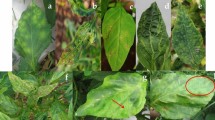Abstract
A survey was conducted in King chilli growing areas of four Northeast states of India namely, Assam, Nagaland, Manipur and Meghalaya for virus disease incidence particularly Cucumber mosaic virus (CMV), Chilli veinal mottle virus (ChiVMV) and Chilli leaf curl virus (ChiLCV). The virus disease incidence based on symptomatology ranged from 15 to 65% with highest incidence recorded in Golaghat district of Assam and lowest in the Ukhrul district of Manipur. The polymerase chain reaction based detection using coat protein gene specific primers for the three viruses revealed the presence of CMV and ChiVMV in all the four states whereas ChiLCV was recorded only in one location from Assam. In two of the samples collected for CMV and ChiVMV, mixed infection of the two viruses was confirmed. Based on molecular method based detection, the incidence of CMV infection in King chilli among all the samples tested for the virus was 32.5% whereas it was 25.97% for ChiVMV.





Similar content being viewed by others
References
Banerjee A, Dutta R, Roy S, Ngachan SV (2014) First report of Chilli veinal mottle virus in Naga chilli (Capsicum chinense) in Meghalaya, India. Virus Dis 25:142–143
Baruah BR, Kashyap A, Nath PD (2016) Incidence, detection and integrated management of viral disease complex in BhutJolokia, a Chilli cultivar in Assam. Ann Plant Protect Sci 24:136–141
Biswas K, Vipin H, Aijaz AZ, Pandey PK (2013) Molecular evidence of Cucumber mosaic virus subgroup II infecting Capsicum annuum L. in the Western region of India. Curr Disc 2:97–105
Borgohain R, Devi J (2007) The hottest chilli: a new horizon in agri-entrepreneurship. Sci Tech Entrepreneur. http://www.assamagribusiness.nic.in
Bosland WP, Baral BJ (2007) Bhutjolokia: the World’s hottest known chile pepper is a putative naturally occurring interspecific hybrid. Hort Sci 42:222
Doyle JJ, Doyle JL (1990) Isolation of plant DNA from fresh tissue. Focus 12:13–15
Hiskias Y (1998) Characterization of PotyvirusIsolates from hot pepper and tomato in Ethiopia. Gottingen, Germany: Institute of Plant Pathology and Plant Protection, Georg-August University, PhD thesis
Katoch M, Abdin MZ, Ram R, Zaidi AA (2003) An overview of diagnostics for viruses infecting gladiolus. Crop Prot 22:153–156
Khan MS, Raj SK, Singh R (2006) First report of Tomato leaf curl New Delhi virus infecting chilli in India. Plant Pathol 55:289
Kumar S, Kumar S, Singh M, Singh AK, Rai M (2006) Identification of host plant resistance to pepper leaf curl virus in chilli (Capsicum species). Sci Hort 110:359–361
Kumar S, Kumar R, Kumar S, Singh M, Rai AB, Rai M (2011) Incidences of leaf curl disease on Capsicum germplasm under field conditions. Indian J Agric Sci 81:187–189
Meena Rishikesh, Patni V, Arora DK (2007) Histopathological changes in leaf of chilli affected by chilli leaf curl virus. Ann Pl Protect Sci 15:509–510
Murmu DK, Hore JK, Hazra P (2014).Genetic variability and character association for fruit quality characters of ripe chilli (Capscum annum L.). In: Proc. Intl. symposium, ISIAAR 6–9th November, 2014, CWSS, p 132
Naresh P, Krishna MR, Hema CRP, Madhavi RK (2016) Screening chilli (Capsicum spp.) germplasm against Cucumber mosaic virus and Chilli veinal mottle virus and inheritance of resistance. Eur J Plant Pathol 146:451–464
Reddy KM, Reddy MK (2010) Breeding for virus resistance. In: Kumar R, Rai AB, Rai M, Singh HP (eds) Advances in chilli research. Studium Press Pvt. Ltd., New Delhi, pp 119–132
Sanatombi K, Sen-Mandi S, Sharma GJ (2010) DNA profiling of Capsicum landraces of Manipur. Sci Hort 124:405–408
Sinha DP, Saxena S, Singh M, Shailesh KT (2013) Phylogenetic relationship of coat protein genomic components of Chilli leaf curl virus. Veg Sci 40:149–154
Talukdar J, Saikia AK, Nath PD (2012) Identification of diseases occurring on ‘BhutJolokia’. In: Detection of fungal, bacterial, viral diseases of ‘Bhutjolokia’ (Capsicum chinense) of Assam. Lambert Academic Publishing
Talukdar J, Saikia AK, Borah P (2015) Survey and detection of the diseases of BhutJolokia (Capsicum chinense Jacq.) in Assam. J Crop Weed 11:186–192
Talukdar J, Mazumder N, Deka KK, Bora P (2017) Occurrence of virus diseases of Bhutjolokia (Capsicum chinense). Indian J Agric Res 51:54–58
Tewksbury JJ, Nabhan GP (2001) Directed deterrence by capsaicin in chilies. Nature 412:403–404
Verma PK, Rawat KK, Das N, Pradhan B (2013) A botanical enigma of India’s hottest chilli BhootJolokia (Capsicum chinense Jacq). N Y Sci J 6:49–51
Acknowledgements
Authors acknowledge the laboratory as well as library assistance from BCKV, West Bengal. We further are thankful to the reviewers and the editor of the article for their critical comments and suggestions on the manuscript.
Author information
Authors and Affiliations
Contributions
N TM, AKS, and NM conceived the idea, surveyed the literature and designed the experiment. NTM performed the experiment and BKS helped and assisted in experimentation. All the authors contributed in writing the manuscript and accept the final version.
Corresponding author
Ethics declarations
Conflicts of interest
All the authors declared no conflicts of interest.
Additional information
Publisher's Note
Springer Nature remains neutral with regard to jurisdictional claims in published maps and institutional affiliations.
Rights and permissions
About this article
Cite this article
Meetei, N.T., Singh, A.K., Singh, B.K. et al. Disease incidence and molecular indexing of viruses infecting King chilli (Capsicum chinense Jacq) in North East India. Indian Phytopathology 73, 117–124 (2020). https://doi.org/10.1007/s42360-019-00169-y
Received:
Revised:
Accepted:
Published:
Issue Date:
DOI: https://doi.org/10.1007/s42360-019-00169-y




